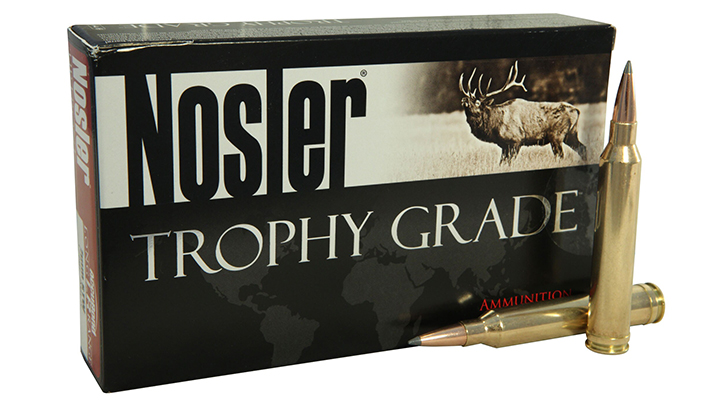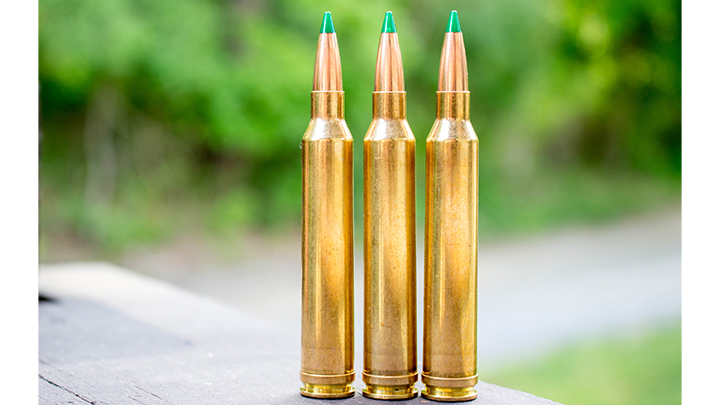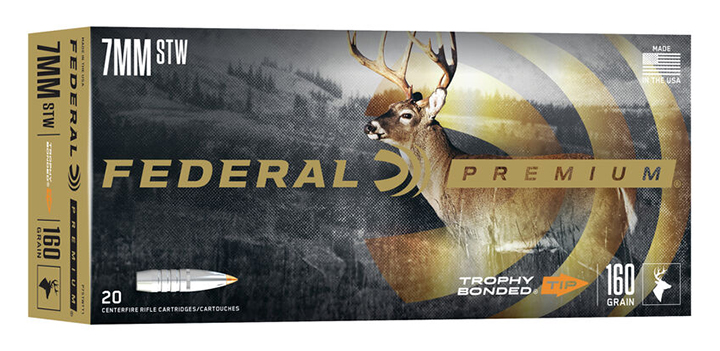
The 7mm bore diameter is one of those all-around choices that Americans have fallen deeply in love with, despite our undeniable aversion to the metric system. Whether we call it 7mm, .28, .280 or .284, the simple fact remains: it is a well-balanced choice which has a range of bullet weights suitable for just about any big game hunting, save the true heavyweights. Mauser showed us the benefit of the 7mm bullets in the late 19th century when he introduced the 7x57mm Mauser, also known as the .275 Rigby in British circles. The lighter 100- and 120-grain bullets are perfect for smaller deer species as well as coyotes, foxes and other furbearers, while the 140- to 175-grain slugs are usually reserved for the larger species. Some legendary hunting figures like W.D.M. Bell and Col. Jim Corbett used the heavy bullets in the 7x57mm/.275 Rigby to take animals as formidable as elephant, buffalo, lion, leopard and tiger.

Though the 7x57mm Mauser is still a wonderfully viable hunting cartridge, it wasn't long before the bullet was stuffed into a more voluminous case in order to achieve higher velocities. In 1912, Holland and Holland released two belted cartridges, one which would go onto fame and glory, and one which would fade into obscurity. The .375 H&H Belted Magnum remains a staple in the hunting world, but the .275 H&H Magnum wouldn’t really catch on. Based on a shorter version of the .375 H&H—cut down to 2.50 inches—the .275 H&H Magnum bears an uncanny resemblance to the 7mm Remington Magnum which would take another half-century to grab the shooting world’s attention. Once the 7mm Rem. Mag. was announced, the hunting world’s love for a speedy 7mm cartridge was cemented. Yes, Weatherby’s own 7mm Magnum was out a bit earlier, but never quite got the reception that the 7mm Remington Magnum did.
Just about every case shape imaginable has been modified to hold both 7mm and .30-caliber bullets, but it was gunwriter Layne Simpson who saw the gap in the lineup: there was no 7mm cartridge based on a full-length .375 H&H case. Simpson took the excellent 8mm Remington Magnum—measuring the same 2.850 inches as the .375 H&H Magnum—and necked it down to hold 7mm bullets in 1979, giving his wildcat the name Shooting Times Westerner. Simpson was a regular contributor to Shooting Times magazine and deemed the cartridge ideal for western hunting, and so the 7mm STW was born. Though Simpson’s design was probably not the first to fill this role, it gained SAAMI acceptance in 1996, becoming a factory-loaded cartridge the following year.

The cartridge maintains the same 3.600-inch overall length as the .375 H&H, so a magnum receiver will best house the long case. Though it uses the belt for headspacing, in my experience best accuracy is achieved when the case is resized to headspace off the 25-degree shoulder. Most belted cases will demonstrate significant stretching upon the first firing, and the 7mm STW is no exception. Much as Simpson intended, the 7mm STW is a speed demon, sending even the heavy-for-caliber 175-grain bullets downrange at a muzzle velocity at or near 3000 fps. Yes, the cartridge is certainly overbore—and has the ability to erode a throat quicker than most—but if the barrel is kept cool and isn’t used for long target practice sessions, it should give a lifetime of service. As should be expected, recoil is on the stout side of things, and the belted case is prone to stretching just above the belt—one reason many shooters embraced the belted 7mm Remington Ultra Magnum as a choice for a fast 7mm.
The 7mm STW will give a very respectable trajectory; the 162-grain Hornady ELD-X load will print 6 inches low at 300 yards when using a 200-yard zero, and only 17 inches low at 400 yards. And even at 400 yards, it retains over 2,000 ft.-lbs. of energy.

Factory ammunition for the 7mm STW is becoming increasingly rare, I’m sad to say. Nosler, which has done a great job of keeping some of the more obscure cartridges alive, offers four different loads for the STW, including the 140-grain Partition, 140-grain and 160-grain AccuBond and the 175-grain AccuBond Long Range. Federal loads their fantastic 160-grain Trophy Bonded Tip at 3100 fps, and Hornady’s Precision Hunter line features the 162-grain ELD-X bullet at 3050 fps. But not all of these factory loads are readily available, even in times of plenty; the 7mm STW just doesn’t generate enough demand to warrant a constant supply, and seems to have been relegated to seasonal or limited runs.
Component brass is available from Nosler—and I really enjoy their brass, as it is wonderfully consistent and ready to be loaded, right from the box—and there are such a wonderful selection of 7mm bullets of all conformations and configurations that a shooter might not have enough time to try even half of them. And, if you are interested in using a 7mm STW rifle with some regularity, handloading the cartridge makes the most sense. Look to a good large rifle magnum primer—I prefer the Federal Gold Medal Match GM215M—and a healthy amount of a slow-burning powder. RETUMBO, H1000, Reloder 19, 22, 23, 25 and 26, IMR7828 and IMR7977, Norma’s MRP and Accurate’s MAGPRO are all solid choices for the big case, so there’s no lack of propellants to choose from.

Has the speed race ended? Have we gotten to the point where the shooting community has officially traded muzzle velocity for ballistic coefficient? Well, I think we’re headed that way, but we’re not there yet, and I’m not sure we need to take the plunge entirely. There are times when in the hunting fields I appreciate the horsepower of faster cartridges, and the 7mm STW certainly has horsepower.
Howard Miller, who has hunted with my dad for well over half a century, uses the 7mm STW for hunting whitetails across the wide open hay lots on the east side of the Hudson River. “Phil, they're dead in their tracks; there’s no need to look for them.” Howie is a crack shot, and has probably shot more deer than I ever will. He is well-versed in ballistics, with plenty of real-world experience, and his endorsement is a strong one for the 7mm STW.
Looking for previous installments of our "Behind the Bullet" series? We've got you covered.
• 6.8 Western
• .375 Ruger
• .223 Remington
• 6.5x55 Swedish
• .416 Remington Magnum
• .300 Winchester Short Magnum
• 28 Nosler
• 6.5 PRC
• .22 WMR
• .458 Winchester Magnum
• .22 Hornet
• .280 Ackley Improved
• .240 Weatherby Magnum
• .458 Lott
• .264 Winchester Magnum
• .348 Winchester
• .33 Nosler
• .260 Remington
• .30-30 Winchester
• .416 Rigby
• .358 Norma Magnum
• .22 LR
• 7mm-08 Remington
• 8mm Remington Magnum
• .338 Federal
• .224 Valkyrie
• .338-06 A-Square
• 9.3x62mm Mauser
• .257 Weatherby Magnum
• .45-70 Government
• .300 H&H Magnum
• .25-06 Remington
• .30-06 Springfield
• 6.5 Creedmoor
• .300 Remington Ultra Magnum
• 7mm Remington Magnum
• .470 Nitro Express
• .280 Remington
• .300 Winchester Magnum
• .270 Winchester
• .222 Remington
• .45 ACP
• .404 Jeffery
• .44 Remington Magnum
• .41 Remington Magnum
• .243 Winchester
• .338 Winchester Magnum
• .357 S&W Magnum
• 6.5-284 Norma
• 8x57 Mauser
• .38 Smith & Wesson Special
• 7x57mm Mauser
• 9mm Luger
• .35 Whelen
• .454 Casull
• .375 H&H Magnum
• .45 Colt
• .22-250 Remington
• 10mm Auto
• .308 Winchester




































